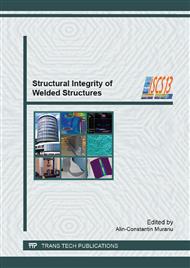p.123
p.127
p.135
p.141
p.147
p.159
p.165
p.173
p.180
Optimization of the Electrode Processing Methodology for Resistance Spot Welding of Aluminium
Abstract:
Lightweight construction materials such as aluminium are being increasingly utilised in new vehicle concepts, with the objective of reducing the CO2 emissions by saving weight. At the same time, the components should, however, be fabricated at favourable cost and with a high quality. In many applications the mechanical joining (clinching, riveting) is applied with great success. Mechanical welded joints show great potential and are especially preferred used for mixed or hybrid joints. In comparison to steel, the resistance spot welding of aluminium have a lower electrode life. Thats an important argument against the widely used, high economically and save welding process. Investigations with various electrode processing systems were conducted at GSI mbH, branch SLV München. In this contribution an overview of the possibilities to achieve a better electrode life is given. The aim was to develop a suitable electrode processing method for the resistance spot welding of aluminium alloys by conducting systematic and scientific investigations in order to substantially increase not only the previously inadequate electrode life but also the electrode tip life. A large number of indications about the effective utilisation of the grinding, polishing, milling and sandblasting processing methods were created by varying the boundary conditions in a defined way and analysing the effect on the life of the electrodes.
Info:
Periodical:
Pages:
147-158
Citation:
Online since:
September 2013
Authors:
Price:
Сopyright:
© 2013 Trans Tech Publications Ltd. All Rights Reserved
Share:
Citation:


